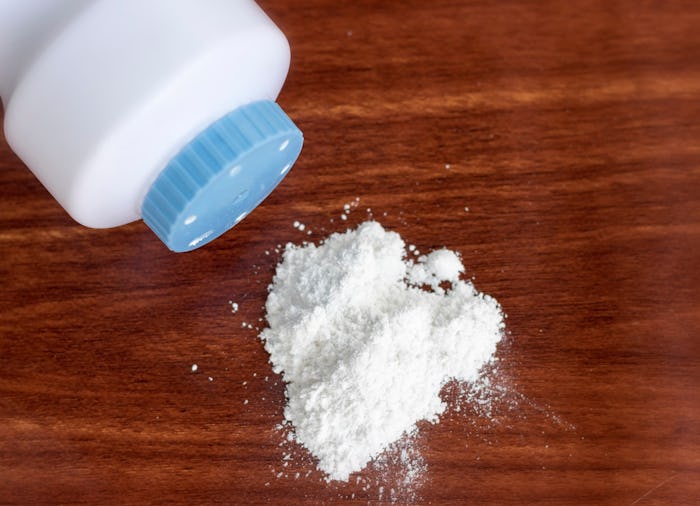News

Contaminated Baby Powders May Be Linked To Rare Cancer, New Study Suggests
A new study published in The Journal of Occupational and Environmental Medicine suggests contaminated baby powders may be linked to a rare cancer. In a case study of 33 patients, researchers found strong evidence that exposure to asbestos-contaminated talcum powder, such as that's often used in baby powders, can result in malignant mesothelioma, a rare but deadly form of cancer known to affect the lungs, abdomen, and heart.
"All the folks in the study used cosmetic talc, usually for decades, and they all had mesothelioma with no other asbestos source," Dr. Jacqueline Moline, professor, Occupational Medicine, Epidemiology and Prevention at The Feinstein Institutes for Medical Research at Northwell Health, and the study's lead author, tells Romper of her team's findings.
Researchers reviewed data, medical records, sworn testimonies, the results of tissue digestions, when available, and even conducted some face-to-face interviews to determine potential asbestos exposure sources. "We couldn't find any other source [of exposure] apart from the cosmetic talc," Moline says.
What Is Talc?
A naturally occurring mineral, talc has a variety of assorted uses, making it a substance found in a number of things. In fact, according to the Minerals Education Coalition, ground talc can often be found in ceramics, paper, paint, roofing, and plastics as well as baby and talcum powders. Because it absorbs moisture well, ground talc is also used in deodorizing powders and some makeup products like blush and facial powders.
But, as the American Cancer Society has pointed out, some talc contains asbestos even in its natural form. Additionally, both the American Cancer Society and the World Health Organization consider asbestos to be carcinogenic, meaning it has been found to cause cancer. When used by consumers, the asbestos fibers in contaminated talcum powders become airborne and are then inhaled by the consumer.
How Does Talc Contamination Occur?
According to the study published Tuesday in The Journal of Occupational and Environmental Medicine, asbestos contamination of talc is believed to occur when mining talc deposits that either overlap or lie too close to naturally occurring deposits of asbestos. When formed as such, it becomes nearly impossible to separate the asbestos from the talc.
What Makes This Case Study So Important?
With over 30 years of experience studying asbestos-related diseases, Moline tells Romper that she noticed doctors often didn't ask about cosmetic talcum powder usage of exposure when taking down the history of a patient who presented with mesothelioma.
"The main reason I wanted to do this is I wanted to alert clinicians that you need to take a comprehensive exposure history," she explains. "We want to make sure that doctors are aware that, for all of these people who have been diagnosed with mesothelioma and no one ever knew why they had mesothelioma and so they were classified as what we call idiopathic, meaning we don’t know the cause, no one ever asked if they used cosmetic talcum powder."
Of course, not every single case of mesothelioma classified as idiopathic will have been caused by contaminated talcum powder. Still, Moline says that she's hoping her research will encourage doctors to ask more probing questions and collect more comprehensive and detailed exposure histories.
Am I At Risk?
Although Moline says mesothelioma is known to be a dose responsive cancer — meaning that the more you're exposed to the carcinogen, the more likely you are to get the cancer — researchers have yet to learn just how much exposure is too much. "There hasn't been any threshold that has been really validated," Moline tells Romper. "We don't have those numbers yet. No one has actually looked for them."
That being said, Moline notes that, "people are exposed from childhood in many cases in [her] paper." Take for example, the exposure history of "Case 2," a 65-year-old woman whose mesothelioma and talcum powder use were discussed in detailed in the published report on the case study. "Case 2" reported having begun using a powder with talc in it daily at around age 8 or 9. The patient also reported using talcum powder when visiting her grandmother, and, because she liked its smell, before dates and even after getting married. "Case 2" also reported coming into contact with baby powder, which contains talc, as a mother as she used it on all three of her children. "Case 2" also reported regularly applying a fragrance's talcum powder morning and night and sprinkling that powder in her lingerie drawer and suitcase beginning sometime in the early 200s.
Moline is, however, quick to stress that mesothelioma is an exceedingly rare form of cancer. Indeed, the American Cancer Society has noted that only about 3,000 cases are diagnosed every year. For comparison, the American Cancer Society reports that breast cancer is the most common type of cancer, aside from skin cancers, to occur in American women. The health organization has estimated that roughly 268,600 new cases of invasive breast cancer will be diagnosed in women in 2019 along with about 62,930 new cases of non-invasive breast cancer.
"I don't want to scare people with this," Moline tells Romper of her case study's findings. "I just want people to be more informed." For those concerned about potential exposure, she suggests using talc-free alternatives.
Studies referenced:
Moline, J., Bevilacqua, K., Alexandri, M., & Gordon, R. E. (2019). Mesothelioma Associated with the Use of Cosmetic Talc. The Journal of Occupational and Environmental Medicine, https://pubmed.ncbi.nlm.nih.gov/31609780/
Experts:
Jacqueline Moline, MD, MSc, Professor, Occupational Medicine, Epidemiology and Prevention at The Feinstein Institutes for Medical Research at Northwell Health
This article was originally published on